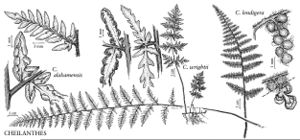Difference between revisions of "Cheilanthes lendigera"
Syn. Fil. 328. 1806.
FNA>Volume Importer |
imported>Volume Importer |
||
| (6 intermediate revisions by 2 users not shown) | |||
| Line 8: | Line 8: | ||
}} | }} | ||
|common_names=Beaded lip fern | |common_names=Beaded lip fern | ||
| − | |basionyms={{Treatment/ID/ | + | |special_status={{Treatment/ID/Special_status |
| + | |code=F | ||
| + | |label=Illustrated | ||
| + | }} | ||
| + | |basionyms={{Treatment/ID/Basionym | ||
|name=Pteris lendigera | |name=Pteris lendigera | ||
|authority=Cavanilles | |authority=Cavanilles | ||
| + | |rank=species | ||
| + | |publication_title=Descr. Pl., | ||
| + | |publication_place=268. 1802 | ||
}} | }} | ||
|synonyms={{Treatment/ID/Synonym | |synonyms={{Treatment/ID/Synonym | ||
|name=Myriopteris lendigera | |name=Myriopteris lendigera | ||
|authority=(Cavanilles) J. Smith | |authority=(Cavanilles) J. Smith | ||
| + | |rank=species | ||
}} | }} | ||
|hierarchy=Pteridaceae;Cheilanthes;Cheilanthes lendigera | |hierarchy=Pteridaceae;Cheilanthes;Cheilanthes lendigera | ||
| Line 30: | Line 38: | ||
|elevation=1300–2400 m | |elevation=1300–2400 m | ||
|distribution=Ariz.;Tex.;Mexico;Central America;South America. | |distribution=Ariz.;Tex.;Mexico;Central America;South America. | ||
| − | |discussion=<p>Cheilanthes lendigera has the small, beadlike ultimate segments characteristic of subgenus Physapteris; the prominent inframarginal false indusia and near absence of multiseriate costal scales serve to distinguish it from all other North American members of that group. T. Reeves (1979) suggested that C. lendigera is a fertile allotetraploid resulting from hybridization between the Mexican species Cheilanthes mexicana Davenport and C. marsupianthes (Fée) T. Reeves ex Windham (unpublished).</p> | + | |discussion=<p><i>Cheilanthes lendigera</i> has the small, beadlike ultimate segments characteristic of subgenus Physapteris; the prominent inframarginal false indusia and near absence of multiseriate costal scales serve to distinguish it from all other North American members of that group. T. Reeves (1979) suggested that <i>C. lendigera</i> is a fertile allotetraploid resulting from hybridization between the Mexican species <i>Cheilanthes</i> mexicana Davenport and C. marsupianthes (Fée) T. Reeves ex Windham (unpublished).</p> |
|tables= | |tables= | ||
|references= | |references= | ||
| Line 39: | Line 47: | ||
-->{{#Taxon: | -->{{#Taxon: | ||
name=Cheilanthes lendigera | name=Cheilanthes lendigera | ||
| − | |||
|authority=(Cavanilles) Swartz | |authority=(Cavanilles) Swartz | ||
|rank=species | |rank=species | ||
| Line 53: | Line 60: | ||
|publication title=Syn. Fil. | |publication title=Syn. Fil. | ||
|publication year=1806 | |publication year=1806 | ||
| − | |special status= | + | |special status=Illustrated |
| − | |source xml=https:// | + | |source xml=https://bitbucket.org/aafc-mbb/fna-data-curation/src/2e0870ddd59836b60bcf96646a41e87ea5a5943a/coarse_grained_fna_xml/V2/V2_674.xml |
|genus=Cheilanthes | |genus=Cheilanthes | ||
|species=Cheilanthes lendigera | |species=Cheilanthes lendigera | ||
Latest revision as of 21:24, 5 November 2020
Stems long-creeping, 1–3 mm diam.; scales uniformly brown or with poorly defined, dark, central stripe, linear-lanceolate, straight to slightly contorted, loosely appressed, usually persistent. Leaves scattered to clustered, 5–30 cm; vernation noncircinate. Petiole usually dark brown, rounded adaxially. Blade ovate-deltate to oblong-lanceolate, usually 4-pinnate at base, 1.5–8 cm wide; rachis rounded adaxially, with scattered linear scales and dense monomorphic pubescence. Pinnae not articulate, dark color of stalk continuing into pinna base, basal pair not conspicuously larger than adjacent pair, usually equilateral, appearing glabrous or sparsely pubescent adaxially. Costae green adaxially for most of length; abaxial scales uniseriate and hairlike. Ultimate segments round to slightly oblong, beadlike, the largest 1–3 mm, abaxially sparsely to moderately pubescent with coarse hairs, adaxially glabrous. False indusia inframarginal, strongly differentiated, 0.25–0.5 mm wide, forming pouch with constricted aperture on abaxial surface of ultimate segments. Sori ± continuous around segment margins. 2n = 120.
Phenology: Sporulating summer–fall.
Habitat: Rocky slopes and ledges, usually on igneous substrates
Elevation: 1300–2400 m
Distribution

Ariz., Tex., Mexico, Central America, South America.
Discussion
Cheilanthes lendigera has the small, beadlike ultimate segments characteristic of subgenus Physapteris; the prominent inframarginal false indusia and near absence of multiseriate costal scales serve to distinguish it from all other North American members of that group. T. Reeves (1979) suggested that C. lendigera is a fertile allotetraploid resulting from hybridization between the Mexican species Cheilanthes mexicana Davenport and C. marsupianthes (Fée) T. Reeves ex Windham (unpublished).
Selected References
None.
